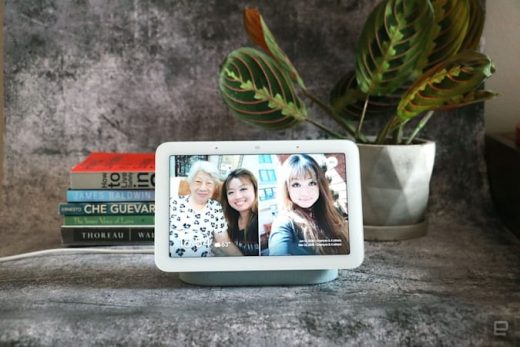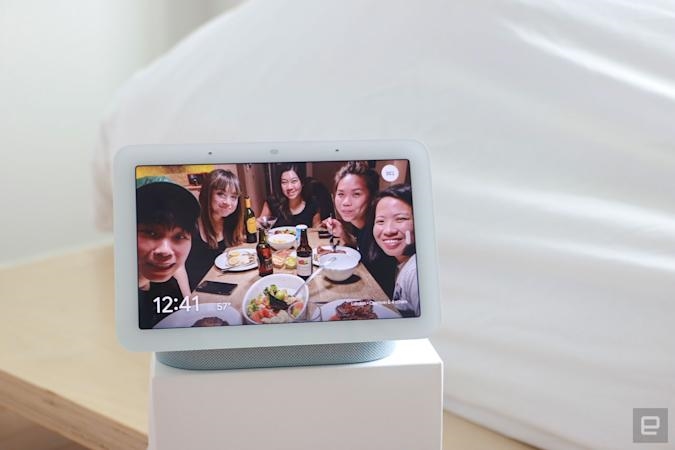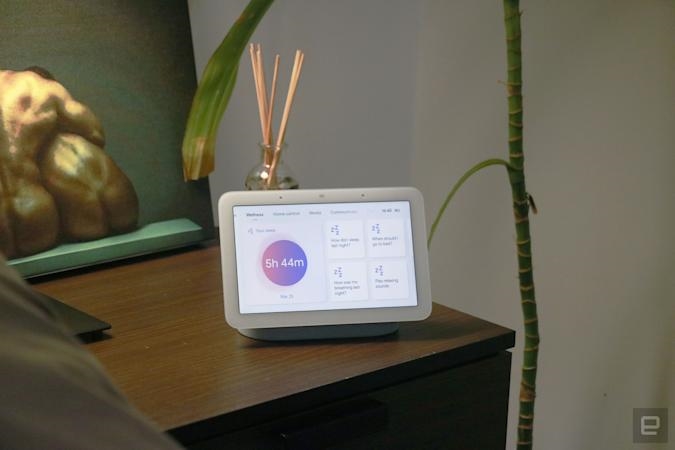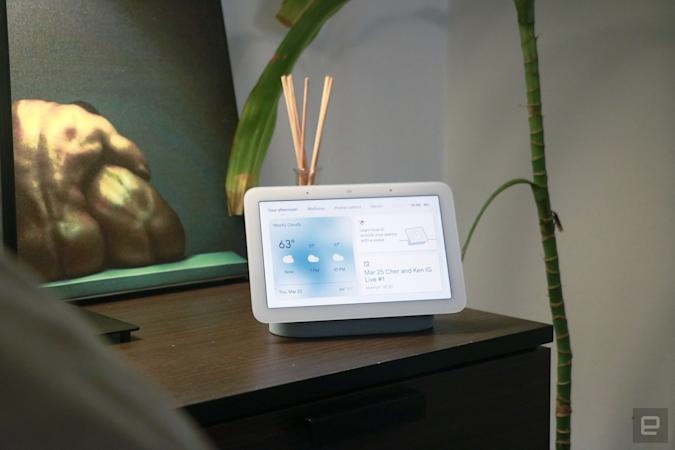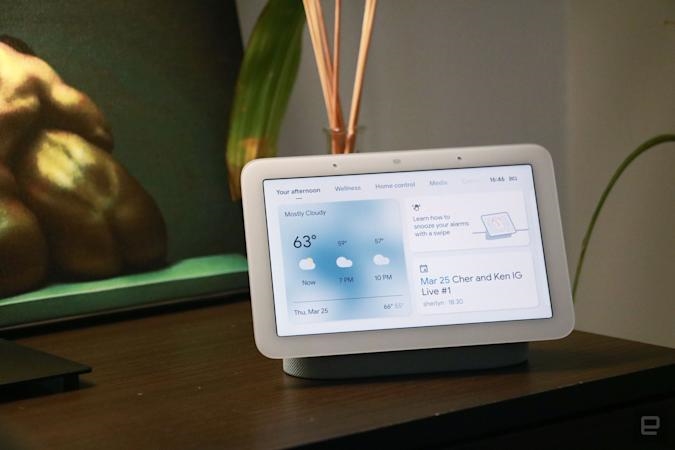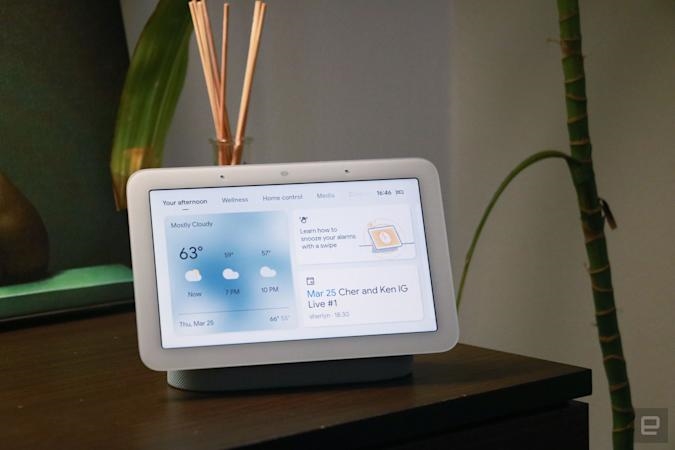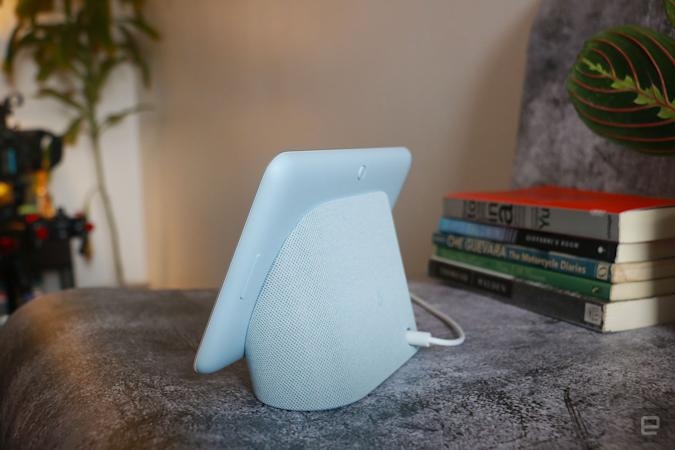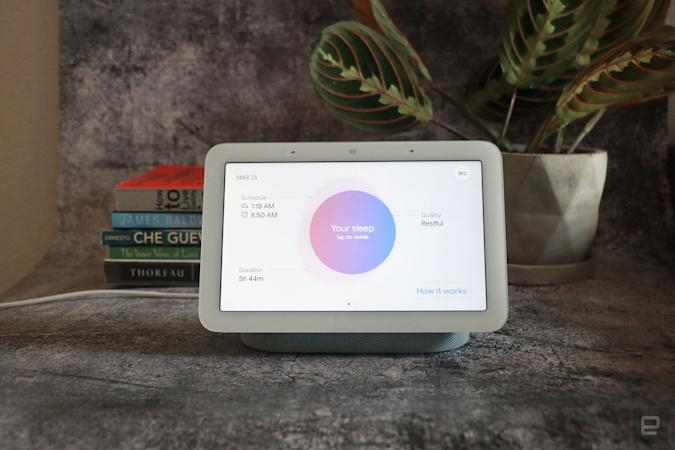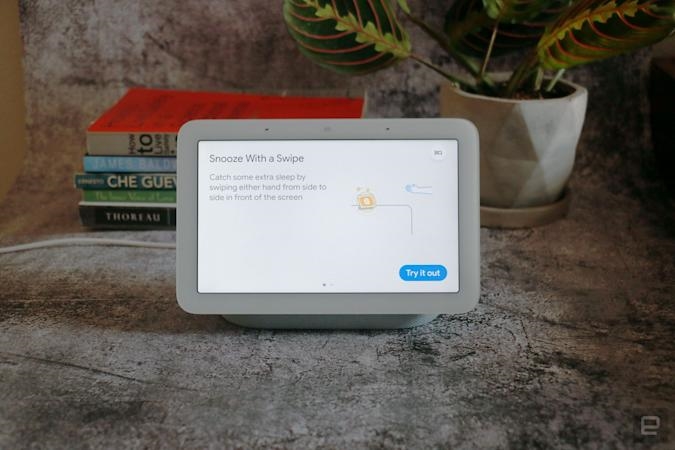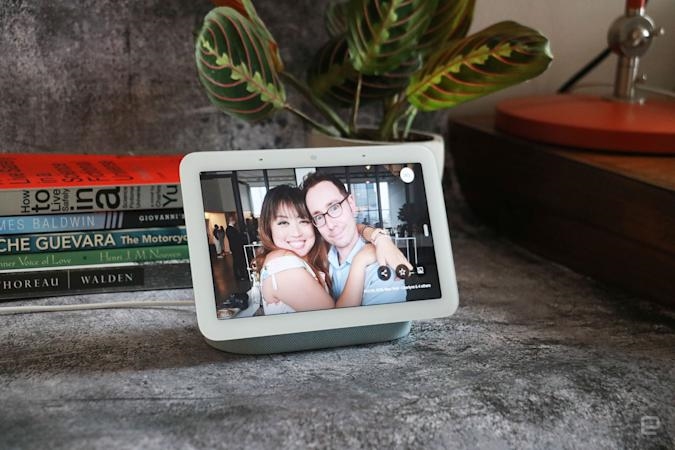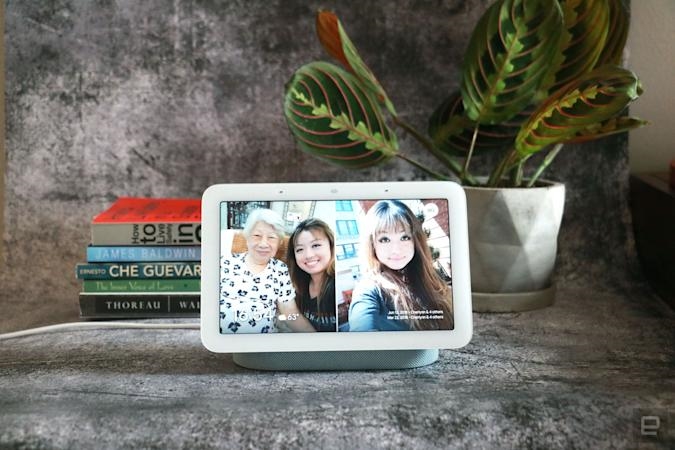Google’s second-gen Nest Hub drops to $60 in New Year’s sale
Google Nest Hub (2nd gen) review: A great smart display and mediocre sleep tracker
As a proof-of-concept it’s impressive, but you probably won’t use the sleep-tracking yet.

The idea of someone or something watching you sleep is creepy as hell — unless you’re Bella Swan from Twilight. But Google’s latest effort in the health and wellness space does almost exactly that. The new Nest Hub has a built-in radar sensor that detects motion in your bed to determine if you’ve fallen asleep, then tracks the duration and quality of your slumber. It’ll also see if you’ve coughed or snored and simultaneously monitor how bright or warm it is in your room. That’s all in the name of helping you sleep better while avoiding the use of an actual camera — an intentional design choice meant to allay privacy concerns.
For $100, the Nest Hub is already a compelling smart display that’s cheaper than the original, with the sleep tracking being an added bonus. But based on my testing, I’m not sure I can count on it to improve my sleeping patterns just yet.
Nest Hub 2nd-gen
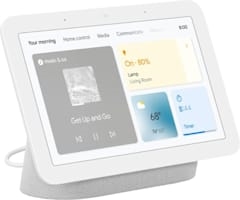
Pros
- Assistant is faster than before
- Clearer and louder audio
- Subtle and pleasant aesthetic
- Accurate sleep sensing
- Cheaper than original
Cons
- Sleep sensing data isn’t very insightful
Sleep tracking by radar
First, the setup. You’d think that you can just stick the Nest Hub on your bedside table for it to monitor your sleep, but it’s a little trickier than that. The display needs to be set somewhere near your head at the same height as your mattress. If your bedside table is taller or shorter, you’ll need to make some adjustments. I don’t have a nightstand and the window ledge I was counting on using was too high up (I sleep on a pretty low platform bed). Plus, the Nest Hub has to be within arm’s reach and facing your torso to sense your motion, so the desk I had on the other side of the room wouldn’t work either. I ended up using boxes and books to create a makeshift podium for the display.
Thankfully, finding a suitable spot was the only hiccup in an otherwise smooth setup process. I connected the Nest Hub to my home network via the Home app and in a few steps I was done. I had to opt in to Sleep Sensing and agree to enable the microphone for detecting sounds like snoring and coughing. Then, I went through a calibration process that involved lying on top of the sheets and staying still for 10 seconds.
Gallery: Google Nest Hub (2nd gen) review
Once I was done, a small bed icon appeared at the top right of the screen to indicate that Sleep Sensing was on. There was nothing left to do but go to sleep and wait for my results the next morning. Did it feel weird knowing my movements in bed would be logged by the Nest Hub? Yes. Did I get used to it over time? A little. Are the rewards worth the uneasiness? Sort of.
Each morning, I eagerly looked at the Nest Hub’s Wellness panel to see how my night went. (You can also just ask Assistant “How did I sleep last night?”) Google’s reports focus on three aspects of your sleep: the duration, quality and schedule, which refers to how well you stuck to a routine of going to bed and waking up at regular times . These are displayed as three circles that overlap almost like a Venn diagram — your goal is to get them to perfectly overlap and become one. The more restful your sleep, and the more closely you stick to your schedule, the more likely your circles will merge.
Despite my occasional efforts to trick the Nest Hub, it was generally adept at recognizing when I’d fallen asleep. Even when I was on my side facing away from the screen for a while, it didn’t get fooled into believing I had drifted off. And though I was still for periods of time, lying awake tormented by my busy brain, the Nest Hub didn’t take that lack of movement to mean I had passed out. For a sleep tracker that relies on motion sensing, this device is surprisingly accurate.
It’s less effective at knowing when I’d awoken though, and counted the minutes (at times hours) I spent rubbing the sleep out of my eyes and dreading starting work as time spent asleep. Only after I dragged myself out of bed did the Nest Hub say I had actually woken up. Google said the display can also track daytime naps that are at least 20 minutes long, though I haven’t been bold enough to actually sleep on the job in the name of testing this out.
Understanding your sleep environment
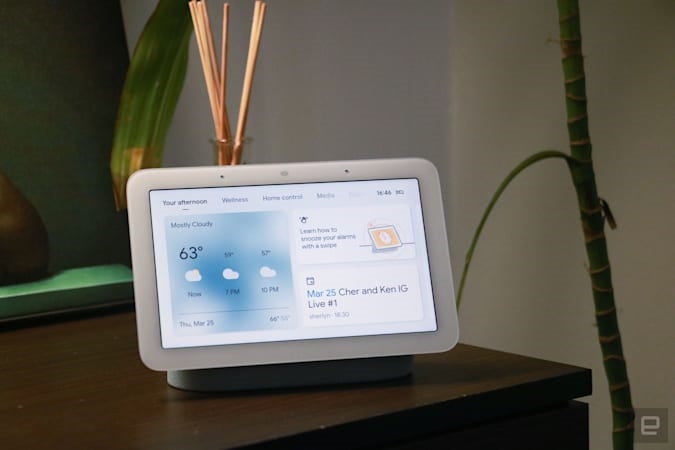
But it did fall short on some fronts. In addition to detecting when you were asleep, the Nest Hub can — with your permission — use its mics, ambient light and temperature sensors to give you more insight on what affects your rest. It’ll also listen for sounds of you coughing or snoring and tell you your respiratory rate.
I’ve never snored in my life (weird flex, I know), so the Nest Hub not registering any snoring for me wasn’t a surprise. But for my colleague Mat Smith, who also has a review unit, Google noted 48 minutes of snoring one night. It also said that I’d coughed one morning after I woke up, though it didn’t catch the one cough I faked the night before.
I’m not sure what to do with the information about snoring or coughing, other than perhaps to run a humidifier if I’m doing that more than usual. I was hoping the Nest Hub could determine if leaving my TV or speaker on while I drifted off was helpful or harmful. But the light sensor didn’t detect the glare coming from my TV or the brightening of my room as the sun rose. The only time it noted a change in light was when I shined my phone’s flashlight directly at the screen. Google also doesn’t point out sounds other than coughing and snoring, so I couldn’t tell if having music on helped me fall asleep.
This is something Google should be able to add pretty easily through a software update, if it can find a privacy-first way to do so. Senior product manager for Google Nest Ashton Udall told Engadget that the reports are meant to show users “what was the most salient aspect of their sleep over the last four nights.” These things include everything I’ve already mentioned like sticking to a schedule, duration of sleep and how long it takes you to fall asleep or get up. If lighting or temperature could be a factor, that’s when Google makes recommendations on changing them to improve your rest. “By doing it this way, we draw your attention to lighting and temperature when they have implications for you personally,” Udall said.
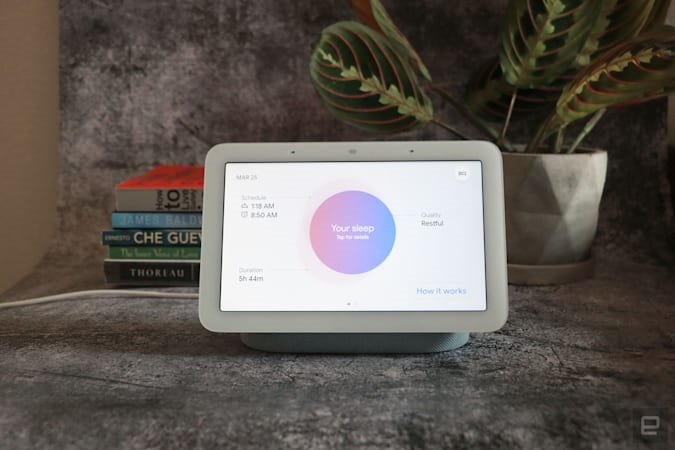
Though it didn’t show me all the data I was hoping for, the Nest Hub and the Fit app’s reports each morning were reassuringly anonymous. I’m not worried that someone seeing my results will get a too-intimate look at my bedtime activities since it’s just stuff like how long Google calculated I was asleep and whether I was restless.
I’ve only had the Nest Hub for a few days, so it’s hard to tell if Google’s promise of proposing changes to my routines will help yet. It needs at least four nights of sleep logged to produce a weekly report and on my fourth morning, I still haven’t seen suggestions to improve my habits. Udall explained that for the first week, you’ll only see this report on your seventh morning, and they will be updated every four days subsequently. Though, I can’t imagine it’ll tell me anything I don’t already know I should do, like going to bed earlier and turning on a blue light filter on my phone.
The Nest Hub is a very different kind of sleep tracker than a wearable. I hate having something on my wrist when I go to bed, but the data gleaned from a Fitbit is more useful for anyone interested in their physiological wellbeing. Google is simply telling you to get more sleep, get in bed earlier and ultimately form habits that help you rest better. You don’t need a whole new display to tell you this. A Fitbit, however, can serve personalized information about what sleep zone you’re in that’s actually more insightful, although it’s a little harder to act on.
The trouble is, Sleep Sensing is a free feature at the moment while Google begins merging with Fitbit. While the company hasn’t shared specifics yet, it does seem like some sort of fee might be coming. At this point, I’m not sure if the Nest Hub offers enough to charge users for this feature or if it will ever be worth a separate subscription.
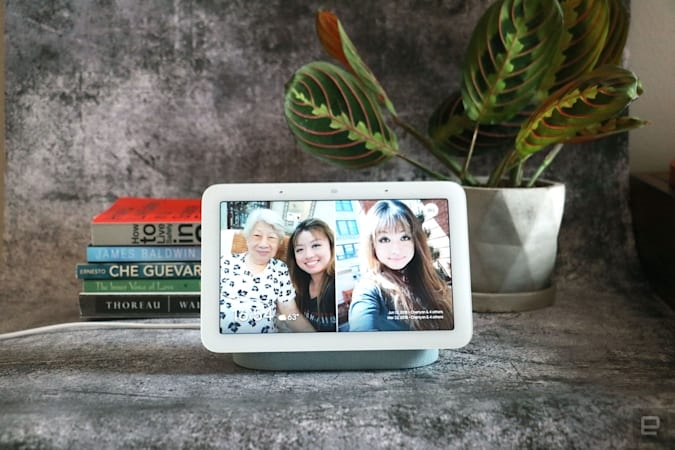
An improved smart display
If you wanted to ignore Sleep Sensing completely, you’d find the Nest Hub is still a very capable smart display. It’s basically the original Home Hub with better audio and some new features. For example, the Soli motion sensor isn’t just for sleep tracking — it also recognizes when you swipe your hand in the air and you can do that to dismiss a ringing timer. This worked well, and though I find it easier to just say “stop” to silence an alarm, it’s a useful option for those who can’t or prefer not to speak.
The new Nest Hub uses the same audio system as the Nest Audio, and it’s a noticeable improvement over the original smart display. Music was louder, fuller and clearer, though it didn’t provide the same amount of bass as the Nest Audio. Also, thanks to a new onboard machine-learning chip, Assistant is faster at responding to requests since it can process them locally instead of relying on WiFi.
Besides these three changes, Google’s latest connected screen offers pretty much the same features as its predecessor. Thanks to software updates over the years, the display now offers a visual interface and dashboards for smart home controls, communications, entertainment and discovery. You can use the Hub to make Duo calls, play YouTube videos or look for recipes. The Assistant is also available for things like weather forecasts, setting timers and streaming music.
These things, and everything we already liked about the original Hub, continue to work well on the new iteration. Don’t worry about the bright screen keeping you up, for example, since like the last model the display dims itself when the environment is dark. Google also kept the same compact design and cute screen size, choosing to simply add a new color option for those looking for something fresh. If you liked the unassuming look of the company’s smart home devices, you’ll appreciate the second-gen Nest Hub’s design.
Wrap-up
Ultimately, the new Nest Hub is an improved version of the original with one notable new feature. While Sleep Sensing is technologically impressive and could be useful for some, a potential fee would be hard to swallow. For $100, though, the Nest Hub manages to outdo its predecessor at a significantly cheaper price, making it a great smart display. As long as you’re not looking for a sophisticated sleep tracker, you’ll find this an excellent addition to your home.
(48)

